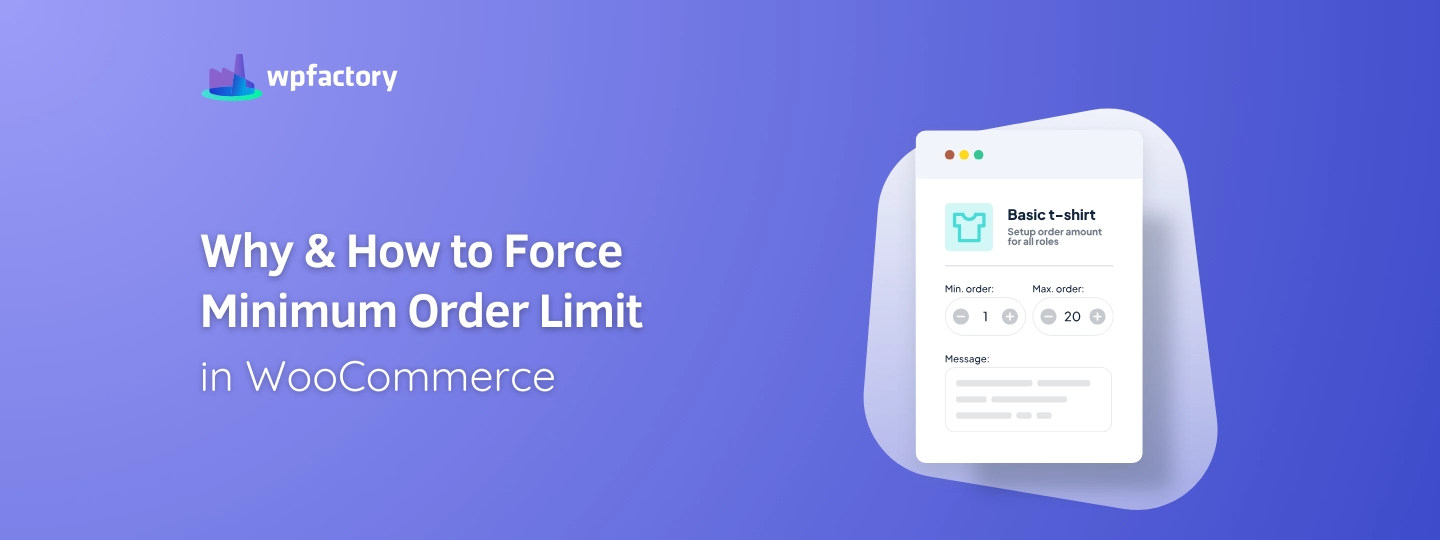Why & How to Force Minimum Order Limit in WooCommerce
Imagine you want to buy a plastic cup, you could buy one cup for $1, 10 cups for $8, or 50 cups for $25. What do you notice here? The cost of a single cup has dropped as the quantity bought increased, right?
Now imagine you go to the supermarket and it says the minimum quantity you could buy is 10 cups and you can’t buy one single cup by itself. That’s what we call setting a minimum order limit.
The main reason suppliers and manufacturers set minimum order limits is that it’s more cost-effective to sell in quantities rather than selling items individually.
In this article, I’ll discuss everything you need to know about minimum order limits, its benefits, how to calculate it, and tips on how to get the most out of it.
Let’s begin…
So What is A Minimum Order Limit?
The minimum order limit set by a supplier or manufacturer is a limit that defines the minimum quantity of a certain item a supplier is willing to sell, he won’t be selling less than that.
For example, imagine a store selling you plastic straws, it says that you can’t buy one single straw by itself instead you have to buy 100 pieces together, that’s what’s called a minimum order limit.
It might seem counter-intuitive at first as to why you want to set a limit when someone wants to buy from you, but manufacturers have other costs such as raw materials and labor costs that would make it more profitable for them to set a minimum order limit so they can assure they don’t lose money in the production process.
Also, it depends on the demand for the item, if the demand for a certain product is high you will probably want to set a minimum order limit for it as it’s almost guaranteed to be sold anyway.
Types of Minimum Order Limit
There are two types of minimum order limits:
- Supplier-set minimum order limit
- Brand-set minimum order limit
Supplier-set minimum order limits are limits set by the supplier to control production costs and make sure profitability is achieved in the production process.
Raw materials, labor, and production costs are all costs that contribute to the manufacturing costs and to bring these costs down you need to mass produce the items you’re selling so the cost of the single unit is driven down to its lowest point possible.
That will produce lots of the items the supplier is producing which means he will want to sell them as many of them as fast as possible, that’s because there still are holding costs post-production where you have to store and maintain the items you have produced.
All of these details contribute to the supplier-set minimum order limits.
You also have brand-set minimum order limits, these limits happen less often and are set by brands mainly to control the supply of their products in the markets, for example, a luxury clothing brand would want to create a sense of scarcity of its products so it would set limits on how much you can of these products.
Benefits of Minimum Order Limits:
Minimum order limits, while sometimes seen as a constraint, offer distinct benefits to both manufacturers and brands. These benefits vary based on their respective roles and goals in the supply chain.
Benefits to Manufacturers:
- Economies of Scale: By setting minimum order limits, manufacturers can ensure larger production runs, reducing the per-unit cost of production. This efficiency arises from spreading fixed costs over a larger number of units.
- Reduced Administrative and Logistic Costs: Handling fewer, larger orders is often more cost-effective than managing many small orders. This approach can reduce administrative overhead and logistical complexities.
- Inventory Management: Minimum order limits help in better inventory management by aligning production with demand. It reduces the risk of overproduction and excess inventory.
- Predictability in Production Planning: With minimum order limits, manufacturers can predict their production needs more accurately, leading to more efficient resource allocation and scheduling.
- Improved Cash Flow: Larger orders typically mean higher revenue per transaction, which can improve the manufacturer’s cash flow.
- Long-term Customer Relationships: Minimum order limits often lead to building long-term relationships with clients who are committed to significant and regular orders.
Benefits to Brands:
- Brand Positioning and Exclusivity: For brands, especially in the luxury segment, minimum order limits can help maintain exclusivity and a high-end image. By controlling the quantity available in the market, brands can create a perception of scarcity and desirability.
- Supply Chain Control: Setting minimum order limits enables brands to have better control over their supply chain. It helps in managing the distribution effectively and ensuring consistent product availability.
- Quality Assurance: Larger orders can often lead to more consistent quality, as manufacturers may give more attention to larger clients. This consistency is crucial for brands that rely on a reputation for quality.
- Strategic Retail Partnerships: Brands can forge stronger relationships with key retailers by setting minimum order limits. This approach ensures that retailers are committed to the brand and reduces the risk of diluting the brand’s presence across too many outlets.
- Effective Marketing and Promotion: With controlled distribution through minimum order limits, brands can more effectively target their marketing and promotional efforts.
- Market Penetration and Expansion: By setting minimum order limits, brands can strategically choose market segments and geographical areas for expansion, focusing on partners who can meet these limits.
How to Calculate Minimum Order Limit:
Calculating the Minimum Order Quantity (MOQ) is a crucial process for businesses, ensuring both economic viability and efficiency in inventory management. Here’s a step-by-step guide to calculate MOQ:
1. Determine Demand
- Understand Your Market: Analyze past sales data, market trends, and customer preferences to estimate future demand for your product.
- Forecasting: Use statistical methods or forecasting tools to predict the quantity of products you will sell in a given period.
- Seasonality and Trends: Account for any seasonal variations or emerging trends that might affect demand.
2. Calculate Your Break-Even Point
- Fixed Costs: Identify all fixed costs associated with producing your product, such as rent, salaries, and equipment costs.
- Variable Costs: Determine the variable costs per unit, including materials, labor, and other costs that vary with production volume.
- Break-Even Formula: Use the formula: Break−EvenPoint=FixedCosts/(UnitSellingPrice−VariableCostsperUnit) to calculate the number of units you need to sell to cover all your costs.
3. Understand Your Holding Costs
- Storage Costs: Calculate the cost of storing inventory, including warehousing fees, insurance, and taxes.
- Opportunity Costs: Consider the opportunity cost of capital tied up in inventory that could be used elsewhere.
- Risk of Obsolescence: Factor in the risk of your inventory becoming obsolete, especially for technology or fashion products.
- Total Holding Cost: Sum up these costs to understand the total cost of holding inventory.
4. Come Up with Your MOQ
- Balancing Act: Your MOQ should be high enough to cover your break-even point and reduce holding costs but low enough to be attractive to buyers and reflect demand.
- Supplier Considerations: If you’re a retailer, consider what MOQs your suppliers have set and how these impact your inventory.
- Market Standards: Look at the typical MOQs in your industry and for similar products.
- Trial and Adjustment: You may need to test different MOQs to find the optimal balance. Be prepared to adjust based on feedback and sales data.
This process involves a delicate balance between ensuring profitability and maintaining an attractive proposition for your customers. It’s important to regularly review and adjust your MOQ as market conditions, costs, and demand patterns change.
How to Set Minimum Order Limits?
The easiest and simplest way to set minimum order limits for a WooCommerce Store is to use the Order Minimum/Maximum Amount for WooCommerce plugin by WPFactory, it’s a simple and easy-to-use plugin that offers lots of options and functionality.
With such a plugin you can control the limits on your products by category, by shipping zone, and by lots of other criteria that you will see when installing the plugin. And it has a free version so you can test the plugin before fully committing to it.







